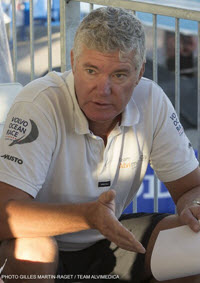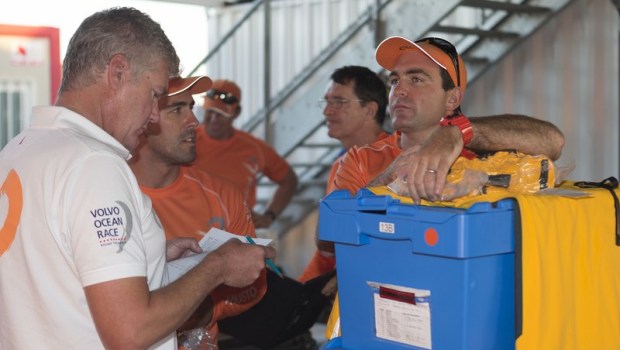Grizzled veteran guides youngest Volvo Ocean Race team
Published on October 30th, 2014
 Bill Erkelens, a former rigger, team manager for the maxi Sayonara, and campaign manager for Oracle Racing when the America’s Cup was in monohulls, is now living the Volvo Ocean Race life as Chief Operating Officer for Team Alvimedica. With the race on it’s first leg from Spain to South Africa, Erik Simonson with Pressure Drop caught up with Bill for this update…
Bill Erkelens, a former rigger, team manager for the maxi Sayonara, and campaign manager for Oracle Racing when the America’s Cup was in monohulls, is now living the Volvo Ocean Race life as Chief Operating Officer for Team Alvimedica. With the race on it’s first leg from Spain to South Africa, Erik Simonson with Pressure Drop caught up with Bill for this update…
How do you compare running an AC team with a Volvo team?
Very similar, but with the America’s Cup you have 3 years of meetings and a few weeks of sailing!
Tell us about Alicante and the preparation before the start.
It was 6 weeks full on. All the team members, including sailing, shore and management teams putting in long days. We had one 1/2 day off in that period. We would arrive at 6:30 in the morning and get home at 10:00 PM. We have the second smallest shore crew with 5, some of the better funded teams had excess crew, so obviously they didn’t have such long days. There was an unexpected issue with bottom paint on all the keel fins, and each of the teams needed to deal with stripping, re-priming and repainting. You play the hand you are dealt and everyone rolled up their sleeves and got dirty. That’s all behind us now and things should be much smoother.
What is the vibe like at the Volvo Ocean Race village?
Its very family like and all the teams help each other out as much as possible. Tools and gear get loaned freely, problems resolved with community effort. The shared services program is working really well which really eliminates a lot of the advantage that rich teams have had in the past and any animosity which might exist between the haves and have nots. It’s a good feel and great vibe.
How about your shore team?
There’s Chris Higgins is the Shore Manager, Marta Lobato manages the logistics, Toby Ingrey does rigging and composites along with Nate Campbell, Anderson Reggio does the navigation support, and Paul Wilson is our Physiotherapist. They are all doing a great job
What happens after the boats leave a port?
The shore crew packs everything up. The crew gear and delicate stuff get packed in the air freight containers and the heavier or more disposable items are loaded into cargo containers and shipped to next port with the village itself. The whole village is gone in a couple days. There are critical bits and pieces cached away in different parts of the planet such as masts, booms, winches, etc that would take too long to ship in an emergency. The final item is the paperwork that needs processing, which Marta and I tend to before departing.
What’s the story on sails?
Each team gets a set of sails plus four additional sails which cannot be used until the China stop. It really equalizes the teams and eliminates the advantage wealthier teams have had in the past. There was also a set of training sails which the teams could keep. For teams like us, which put in a lot of training days on them, they were pretty much reduced to rags. For teams like Vestas Wind which entered late, their sails have quite a bit of life left, so that’s a little bit of advantage. The shared event services will take care of sails when they get to port, and teams can carry a sewing machine on their own, but it has to be stowed on the center line and cannot be stacked.
So when the teams arrive in port, are they expected to roll up sleeves again?
The race organizers have most of the maintenance stuff covered via the shared service. We expect our shore team to be able to handle all the rest of boat needs and the sailing crew can rest. They are going to be pretty beat up by the time they get to port and will really need it.
What’s your guess as to your whether the stand-bye crewmembers will be getting some action?
BE: I think it’s very good. Historically, very few make it all the way around the world. We have Matt Noble available for any general position, Stu Bannatyne available as watch captain, and Anderson Reggio available as navigator.
Your thoughts on piracy which disrupted the previous edition?
Historically it’s at an all-time low. The bad guys were beaten back severely by a number of nations, and no longer see pirating as an easy option. There were 412 acts of piracy for a calendar year during the last race cycle. This year there has been three total. That being said, if wind gets light in the notorious waters, Volvo does have contingency plans.
How much time to you expect to be able to spend at home with family during the race?
Not much. In fact there won’t be much time between Abu Dhabi and Sanya, so Melinda (wife) and the kids will be coming to Abu Dhabi for Christmas!
Team Alvimedica:
Team Alvimedica is the youngest entry in the Volvo Ocean Race 2014-2015, the world’s toughest and longest sporting event. The crew is led by American skipper Charlie Enright, age 30. Alvimedica, the European based medical devices company, is the team’s owner. Founded in 2007, Alvimedica is a fast growing challenger in the global field of interventional cardiology, committed to developing minimally-invasive technologies. This is the team’s first entry in the extremely challenging 39,000-mile race that started October 11, 2014 from Alicante, Spain and features stopovers in 11 ports around the world. www.teamalvimedica.com
Volvo Ocean Race:
The 2014-15 Volvo Ocean Race began Leg 1 on October 11, which takes the 7 teams 6478nm from Alicante, Spain to Cape Town, South Africa. ETA is Oct. 31 – Nov. 9. Racing the new one design Volvo Ocean 65, teams will be scoring points in 9 offshore legs to determine the overall Volvo Ocean Race winner. Additionally, the teams will compete in 10 In-Port races at each stopover for a separate competition – the Volvo Ocean Race In-Port Series. Final finish on June 27, 2015 in Gothenburg, Sweden. www.volvooceanrace.com









 We’ll keep your information safe.
We’ll keep your information safe.